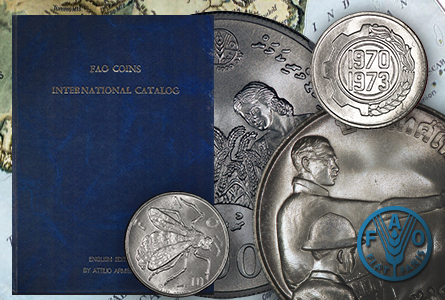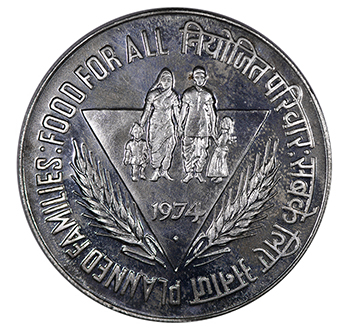First Read, a CoinWeek continuing series of essays about classic and contemporary works of numismatic literature…
Review by Charles Morgan and Hubert Walker for CoinWeek…
FAO Coins International Catalog. English Edition 2013, by Atilio Armiento
Italian collector Atilio Armiento has published a fantastic resource for collectors of F.A.O. coins entitled FAO Coins International Catalog.
The F.A.O. coin program was an ambitious international coin program developed by the United Nation’s Food and Agriculture Organization.
Its purpose was to create global awareness of the work of the F.A.O. and galvanize people to work towards eliminating food insecurity in the developing world. Seignorage and profits from the sale of the coins helped fund these important programs.
F.A.O. coins were first issued in 1968, at a time when interest in world coins was growing. More than 20 countries participated that year. While the United States and many NATO-allied countries didn’t issue F.A.O. coins, the San Francisco Mint, the Royal Mint in London, and mints in Germany did strike F.A.O. coins for other nations. Private mints, such as the Franklin Mint, struck coins as well.
 Many issues were made for circulation, but collectible pieces–some in silver and gold–were also struck. These coins, which today would be classified as Non-Circulating Legal Tender (NCLT), were sold at a premium to collectors and investors.
Many issues were made for circulation, but collectible pieces–some in silver and gold–were also struck. These coins, which today would be classified as Non-Circulating Legal Tender (NCLT), were sold at a premium to collectors and investors.
That no ready reference exists to the coins is stifling for a series of such appeal and historical significance. Outside of some contemporaneous leaflets and pamphlets, nothing major has been done to bring the series into focus.
Fortunately, Italian collector and author Atilio Armiento’s FAO Coins International Catalog is a capable stopgap until the “definitive” work comes along.
Armiento’s Catalog boasts 1,214 F.A.O. coins, listed in denominational order by country from 1968 to 2008 (the year officials at the F.A.O. ended the program). Information about each coin comes primarily from previously-published F.A.O. documentation–most of which was included with original sets and individual coins–published by the F.A.O.’s Rome office.
The catalog is thorough and includes subsequent issues from series initially released in F.A.O. albums and money boards.
One such issue is the South Korean 50 won, which debuted in 1972 and was included in money board number three (although several number threes were distributed with 50 won coins dated 1973). Armiento reserves 34 slots in his catalog system for this series.
Armiento also includes a handful of “unofficial” F.A.O. coins, such as the Ajman five and 75 riyal coins of 1969-1970 and the myriad North Korean issues of 2002, which, along with the Castro-era F.A.O. issues of 1981-1996, are difficult for collectors in the United States to acquire due to longstanding trade embargos. When known, pattern issues and essay pieces are included as well.
 The Catalog offers valuable insights into a range of topics necessary for the understanding of post-World War II international coinage. The most important of which is the growth of Legal Tender Non-Circulating coinage, of which the F.A.O. series has a number of examples. Furthermore, the information that Armiento gathers concerning participating mints documents vital relationships between wealthy industrialized nations and the developing world during the latter half of the Cold War.
The Catalog offers valuable insights into a range of topics necessary for the understanding of post-World War II international coinage. The most important of which is the growth of Legal Tender Non-Circulating coinage, of which the F.A.O. series has a number of examples. Furthermore, the information that Armiento gathers concerning participating mints documents vital relationships between wealthy industrialized nations and the developing world during the latter half of the Cold War.
These relationships surprised even us. Just one example: the South Vietnamese contracted with Germany to produce its F.A.O. dong coinage, while the unified communist government had their F.A.O. coins struck in Cuba. Like we said, this area by itself is fascinating.
Armiento also includes mintages, a rarity index (that we essentially ignore) and a price “guide” listed in Euros. To F.A.O. “investors” and collectors, take this and any world coin price guide with a grain of salt. It’s a thin and unpredictable market and patience is key, whether buying or selling.
The book succeeds as a catalog. In some respects, it is reminiscent of the F.A.O. pamphlets put out in the 1970s by the German firm Deutsche Münze. Those catalogs, like this one, derive much of their information from literature already published by the F.A.O. Much of that information was disseminated in loose leaf form, so a compilation of data is a long-overdue convenience.
Why F.A.O. Coins Matter
Perhaps the strongest selling point of the Catalog is that we are reminded how much F.A.O. coins matter, not only as collectibles but also as reminders of basic human dignity and the enduring power of international cooperation on important issues, such as food insecurity.
F.A.O. coinage also illustrates the propaganda value of coins. History has shown such things can be used for good and bad, and it behooves us to remember that this is a primary function of coin art.
For students of modern coins, the F.A.O. coin program is a master course in international coin production, distribution and marketing. It’s also further proof of the long odds against a payoff from “investing” in programs like this.
But as with much else in Numismatics, the situation has its pros and cons. To someone of a mind to invest in coins, it isn’t encouraging that a series issued more than 40 years ago is available now for less than its original offering price (what else is new with moderns, right?). Yet for that very reason, now is the perfect time to cherry pick conditionally rare examples that have a demonstrated track record for selling at tidy profits if favorably graded.
With many dealers entering the world coin market, series like the F.A.O. have good “opportunity” potential. Should NGC or PCGS add F.A.O. to their respective set registries, collector interest would increase for better grade issues, especially for the dozens of silver and gold issues, low mintage proof issues, and patterns.
But even if you don’t buy into third party certification, the albums and coin boards as originally issued are handsome and well crafted.
The Book Itself
The edition reviewed here is available on eBay directly from the author. The book that we purchased is a sturdy blue leatherette hardcover edition. Pictures are mostly black and white, with passable though not quite plate quality images of nearly every issue in the series. To this point in time, Armiento’s Catalog represents the best compilation of information on the F.A.O. series available.
FAO Coins International Catalog. English Edition 2013
by Atilio Armiento
375 Pages. Self-Published. Hardback. $69 (+$29 Shipping from Italy).
© 2014 CoinWeek LLC
__________________________________________________________
XXXXXX Currently Available on eBay
[wpebayads]





Thanks for bringing this to everyone’s attention. I’ve been keeping my eye on this product on ebay. It’s too bad it’s so expensive though. It’s probably worth it, considering the subject matter, good looking book, etc. But 30 bucks for international shipping seems like a lot of money to lose. I’ll keep watching for now
Reply to Joe s.
Just an information.I wrote this catalogue because nobody made it before and because ,how FAO coins collector, wanted systematically gather all of the FAO coins existing in the world with all the informations usefull about them. I don’t earn about selling the book. The cost to print the book with about 4 hundred high quality paper pages (few copies every time costs to me 80% of sell price).The shipping cost to USA for me is 35.00 US dollars.In any case my satisfaction is the wonderfull feed back received by FAO collectors who bought the book.
Regards
Attilio
Hello, Attilio
I would like to talk to you about a translation partner of the catalog into Portuguese,
Greetings, Leonardo
My email: 7leofreitas [at] gmail [dot] com
Hi Attilio!
I’m looking for information about the FAO CERES Gold Token. Apparently they have different gold content, but the most of them seems to be without “Gold-content-punch” !?!?
Have you any idea where I can get more information?
Thanks – Steve
I decided to purchase this catalogue from Attilio after enormous amount of internal consideration, mainly due to high price and on top of that too high shipping charge. I am very happy that I bought this beautiful compilation of Attilio. KM catalogue does not list all FAO coins as “FAO” and their guidance pricing is not reflecting the market demand for FAO coins. This catalogue is the best collection to possess if you are aiming to complete your entire FAO collection, which I do. I have added more than 300 coins after I purchased this catalogue because I could judge how much I need to pay to buy a particular FAO coin. I am now almost at 70% completion of my FAO collection. Thank you Attilio for your wonderful work.
How and where can I buy this book. Currently I am in India. Please advice.,?
Hello Attilio!
I would like to buy your beautiful catalog with shipment to Russia.
How can this be done practically and how much will it cost?
Best regards, Arkadiy.